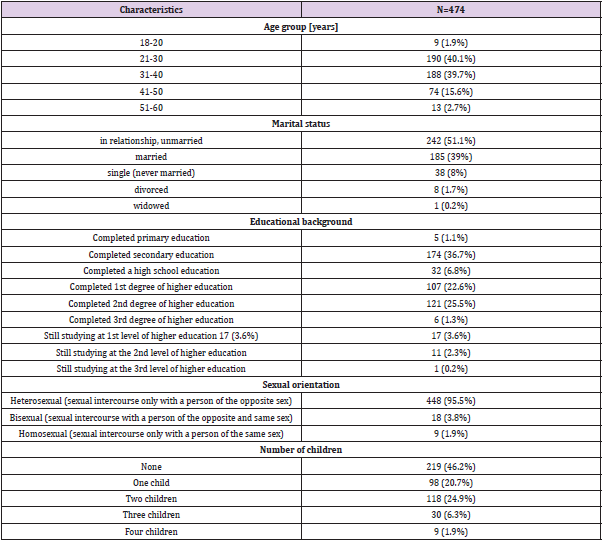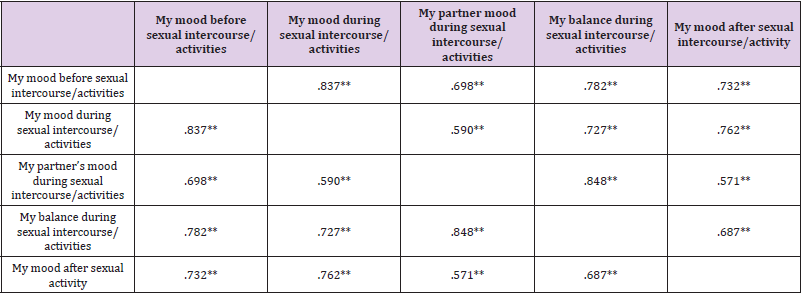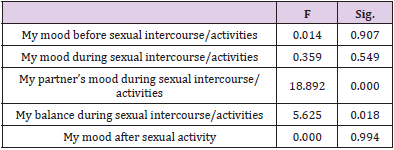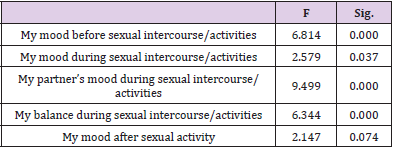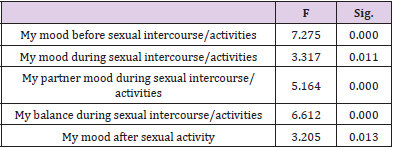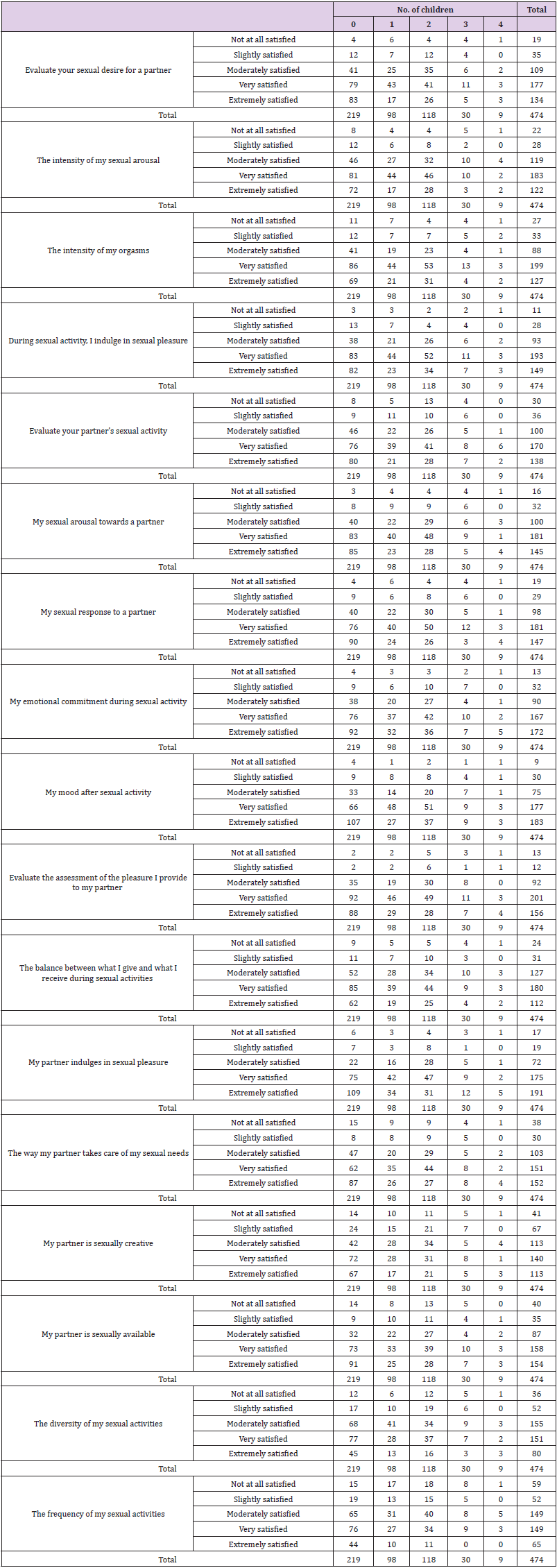Abstract
The aim of the study was to determine sexual satisfaction in the Slovenian
population using a newly modified questionnaire. The study was conducted by online
survey and included 474 adults of both sexes. The analysis showed that previous
experience with more sexual partners (F=2.990; p=0.007), a higher number of monthly
intercourse and orgasms before (F=19.405, p= 0.001) and during sexual intercourse
(F=15.277; p=0.001), were associated with better sexual satisfaction. The same was
observed for the number of orgasms per month and mood before (F=14.252; p=0.001),
mood during (F=28.758; p=0.001), partner’s mood during intercourse (F=9.321;
p=0.001), balance during sexual contact/activity (F=9.742; p=0.001), and mood after
sexual activity (F=11.396; p=0.001). In our study, participants without children were
the most satisfied with their sex lives, followed by participants with only one or two
children. There were statistically significant correlations between participants who
had no children and mood before, during, and after sexual intercourse, partner mood
during and after sexual intercourse (both p=0.001), and mood after sexual activity
(p=0.013).
Younger age from 21 to 30 years was significantly associated with mood before,
during and after sexual intercourse (p=0.001 for each). Accordingly, for older
participants, the quality - rather than quantity - of sexual encounters was a more
important predictor of higher sexual satisfaction. In our study, we did not specifically
measure quality per se, but attempted to estimate quality based on pleasure, number
of sexual encounters, and orgasms. This could be the reason why younger participants
experience better sexual satisfaction than participants in older age groups. By
measuring sexual satisfaction using mood pillow ratings, the questionnaire is a suitable
tool for further evaluation and for a larger sample to obtain additional data on factors
that might influence sexual satisfaction.
Keywords: Sexuality; Sexual Intercourse; Sexual Satisfaction; Sexual Interaction; Sexual Response
Introduction
Partnership not only satisfies the basic needs of the
individual as a social being, but also contributes to health,
positive interpersonal relationships, self-confidence, good
self-esteem, and general well-being [1,2]. Sexuality is also
crucial for good partnership and an important part of the
human life cycle [3-5]. Sexual orientation is a predisposing
characteristic of a person who is sexually attracted to persons
of the same and/or opposite sex. Sexual orientation refers to the
gender to which a person is emotionally, physically, sexually, and
romantically attracted. It is primarily assessed through personal
evaluation and reporting of whether one is attracted to a man or a woman [6,7]. Engaging in sexual relationships with persons of
the same or opposite sex most often determines a person’s sexual
orientation. Factors that influence whether a person has sex with a
person of the same or opposite sex include availability of a partner,
moral relationships, social norms, curiosity, need to fulfill the role
of a parent, financial motives, etc. [8].
In sexuality it is necessary to separate the masculine and
feminine sides. Men are more pragmatic beings, while women are
more tactile beings. Therefore, an embrace is of great importance
for a woman’s perception of sexuality, as the release of serotonin,
dopamine and oxytocin then increases. A woman, who is otherwise
a hyperdynamic being and has all her senses constantly activated,
usually closes her eyes when kissing. This activates the depilation
of the basic system of the visual sense, with which we reach the
maximum information capacity of up to 90% [9]. Therefore, the
aim of the study was to assess sexual satisfaction in the general
Slovenian population using an adapted but modified questionnaire,
which was suitable for identifying differences in sexual satisfaction
between different variables.
Methods
The study was conducted on female and male participants
via online survey. The online survey began in July 2020 and was
completed in September 2020. The research was conducted
according to the principles of the Declaration of Helsinki. All
participants were informed of the aims and anonymity in writing
before the study began. Informed consent was given by clicking
the “Proceed with questionnaire” button. The National Ethics
Committee approved the study design (No. 0120-200/2020/6).
Recruitment was based on the following inclusion conditions:
(a) Age of 18 years and older, and
(b) Personal consent to the questionnaire.
Participants with mental and sexual disorders were also
included in the study. All participants were asked for demographic
data: gender, age, marital status, education level, sexual orientation,
number of children, number of all lifetime sexual partners, number
of current sexual partners, number of sexual contacts per month,
diagnosed mental and/or gynecological disorders and, for women,
the number of archived orgasms during a sexual contact.
A validated questionnaire from Stulhofer, et al. [10] was
used with some adaptations that allowed the questionnaire to be
completed by both sexes. Linguistic validation of the questionnaire
was done by translating it from English to Slovenian and vice
versa. The Cronbach’s alpha coefficient showed adequate internal
consistency (α=0.963) for all statements. Based on the theoretical
content relationship, we grouped certain statements into new
cushions/variables:
My mood before sexual intercourse/activity (α=0.936):
• My sexual arousal toward a partner.
• Rate your sexual desire toward a partner
• My sexual response to a partner
• The intensity of my sexual arousal
My mood during intercourse/sexual activity (α=0.854):
• My emotional engagement during sexual activity.
• During sexual activity, I give myself to sexual pleasure
• The intensity of my orgasms
My partner’s mood during intercourse/sexual activity
(α=0.936):
• Rate your partner’s sexual activity
• My partner gives in to sexual pleasure
• The way my partner is responsive to my sexual needs
• My partner is sexually creative
• My partner is sexually available
My balance in sexual intercourse/activities (α=0.857):
• Rate the appreciation of the pleasure I give to my partner.
• The variety of my sexual activities
• The frequency of my sexual activities
• The balance between what I give and what I get during sexual
activity
• And the autonomic variable:
• My mood after sexual activity.
The modified questionnaire consisted of demographic data and
17 statements. A 5-point Likert scale was used for each statement,
ranging from “not at all satisfied” to “extremely satisfied.”
Data were analyzed using SPSS 26.0 statistical software. The
Kolmogorov-Smirnov test and the Shapiro-Wilk test were applied
to determine whether the values had a Gaussian distribution and
to choose between parametric and nonparametric statistical tests.
The Kolmogorov-Smirnov test and the Shapiro-Wilk test showed
a non-normal distribution. Based on this result, a non-parametric
statistical analysis was chosen, namely Pearson’s correlation
coefficient and χ2 -test. The statistical significance was set at p ≥
0.05.
Results
A total of 1418 questionnaires were received, of which 474 were fully completed. The realization of the sample was 33.43%. The sample included 405 female (85.4%) and 69 (14.6%) male participants. The basic demographic data are presented in Table 1. Participants were asked about the total number of sexual partners in their lifetime (Table 2). Most had one to two (n=134; 28.3%). Regarding the number of current sexual partners, respondents had one (n=462; 97.5%) or two to three (n=12; 2.5%) sexual partners (Table 2). In addition, the majority of participants had 11 or more (n=98; 20.7%) sexual contacts per month (Table 3). The female representatives were additionally asked about the number of orgasms during sexual intercourse. Most achieved two (n=178; 37.6%), three (n=110; 23.2%), one (n=69; 14.6%), and four or more (n=50; 10.5%) orgasms. Thirty-one (6.5%) participants did not have an orgasm, and 36 (7.6%) responses were missing. Twentysix (5.5%) participants were diagnosed with a mental disorder and 14 (3%) with a gynecological disorder. These individuals were also included in the study as we were interested in finding possible correlations.
Based on Pearson correlation coefficient, strong correlations were found between mood before intercourse/activities and mood during intercourse (r=0.837), balance during intercourse/activities (r=0.782), mood after intercourse/activities (r=0.732) and partner’s mood rating during intercourse/activities (r=0.698). There were also correlations between mood during intercourse/activities and mood afterwards (r=0.762), balance during intercourse/activities (r=0.727), and rating of partner’s mood during intercourse/ activities (r=0.590). And between rating partner’s mood during intercourse/activities and balance during intercourse/activities (r=0.848) and mood after intercourse/activities (r=0.571) (Table 4). Female representatives were associated with partner mood and balance within sexual activity (Table 5). Male representatives showed no correlations with any of the cushions. In addition, correlations were found between an age group of 21 to 30 years and mood before, mood during, partner’s mood during, and balance during sexual intercourse/activities (Table 6).
Discussion
Although there are quality of life questionnaires that include
questions about sexual satisfaction in the context of chronic disease,
there is not much evidence of questionnaires that fully capture
sexual satisfaction in the general population. Previous analyses
included more women and examined the influence of menopause,
body image, psychological distress from chronic disease,
discomfort with sexual intercourse, and satisfaction with sexual
intercourse. However, as far as we know, there is no questionnaire
that includes different variables that could also influence men’s
sexual satisfaction. Therefore, the aim of this study was to modify
the already established questionnaire to more accurately capture
the variables that have an impact on sexual satisfaction, in this case
in a general Slovenian population. In our analyses, we included the
general population of men and women and even individuals with
mental and/or gynecological disorders. The questionnaire was
adopted from Stulhofer et al. (2009) and modified to fully capture
the sexual satisfaction of men and women from our population.
Based on the achieved reliability of the questions and results,
we believe it can be used as a simple tool for clinicians in daily
practise to facilitate communication about sexual satisfaction.
Examination of correlations between general parameters such as
gender, marital status, number of children, sexual intercourse per
month, orgasms per activity and dependent variables for sexual
satisfaction such as mood before, during and after intercourse and
balance within intercourse showed interesting results. Satisfaction
correlated well with mood before, during, and after sexual activity
and, more importantly, with balance within intercourse. Important
here are the questions that measure balance within sexual activity:
‘rating how much pleasure I give my partner’; ‘variety of my sexual
activities’; ‘frequency of my sexual activities’; and ‘balance between
what I give and what I receive during sexual activities’. This clearly
shows that sexual satisfaction depends on the correlation with
the activities of the participants and their partners during sexual
intercourse. This was even confirmed by the correlations between
female representatives and their partner’s mood (F=18.892; p
0.001) and balance during intercourse itself (F=5.625; p=0.994).
In several studies by Basson (2000, 2005, 2015) [11-13], the
authors showed that women’s sexual desire is highly dependent on
current relationship and partner dynamics, proving that women’s
motivation for sexual intercourse does not necessarily arise from
sexual desire, but is likely determined by the relationship [14-
17]. In addition, the results of our study proved that previous
experience with more sexual partners, higher number of monthly
sexual intercourse and orgasms, and younger age were associated
with better sexual satisfaction. In addition, participants with more
children showed lower sexual satisfaction. Having more children
could affect sexual activity and thus sexual satisfaction. Intimacy
is an important factor for women with children. The presence of
children lowers the level of intimacy as women begin to ignore
their sexual arousal because they focus primarily on the children
and the family relationship [18,19].
Both were evident in our study, as participants without
children were the most satisfied with their sex lives, followed
by participants with only one or two children. Satisfaction
decreased with the number of children, such that participants
with three or four children were the least satisfied with their sex
lives. In addition, there were statistically significant correlations
between participants who had no children and mood before,
during, and after sexual intercourse, partner mood during and
after sexual intercourse (both p=0.001), and mood after sexual
activity (p=0.013). In addition, Dewitte, et al. [20] showed that the
situation of not having children increases sexual activity in women
and even decreases the negative effect of sexual desire on sexual
activity. Sexual satisfaction was also associated with the age of
the participants. Age from 21 to 30 correlated with mood before
and during intercourse, mood of partner during intercourse, and
balance during intercourse. Increasing age is associated with lower
quality of life [21] and therefore could also affect sexual aspects of
life, such as number of intercourses per month, number of orgasms,
and overall satisfaction.
However, there is a contradictory variable that could affect
sexual satisfaction. Namely, in our study, the number of sexual
partners also showed a correlation with satisfaction. In this case, we
would expect older participants to have better sexual satisfaction
than younger ones, but this was not the case. One reason for this
is the specificity of the questionnaire we used in our study. The
questionnaire specifically addressed sexuality and sexual activity
rather than overall quality of life. A middle-aged person may have
a higher quality of life than a person aged 21 to 30 because their
life priorities lie elsewhere. Here we have not come across the
financial influences, career, family and social status. These are all
factors that significantly affect the quality of life. On the other hand,
life experience in sexuality, as people learn more about their sexual
preferences or those of their partner over the course of their lives,
could also be an interesting influencing factor on sexual satisfaction.
This is suggested by the study of Forbes, et al. [21], who found
opposite results when examining sexual quality of life with age.
They observed a positive relationship between age and sexual
quality of life. Accordingly, for older participants, the quality - rather
than quantity - of sexual encounters was a more important predictor
of higher sexual satisfaction. In our study, we did not specifically
measure quality per se, but attempted to estimate quality based on
pleasure, number of sexual encounters, and orgasms. This could
be the reason why younger participants experience better sexual
satisfaction than participants in older age groups. The number of
sexual encounters became less influential with age [22]. However,
in both reports, age was associated with a decrease in sexual
aspects of life. Our modified questionnaire was informative enough,
showed good reliabilities of variables of significantly above 0.8, and
can potentially be used in daily clinical practice.
However, there were limitations in this study. Despite the
large sample size, the questionnaire should be validated in further
studies to obtain additional information about the reliability of
the questions. Also, more comparisons should be made between
different parameters such as gender, marital status, and sexual
orientation to gain truly meaningful insights into the variables
that influence sexual satisfaction. In addition, a larger sample
of men should be included in the future, as the results cannot be
generalized to the general population due to the predominantly
female participants. As this study was designed as a pilot study, we intend to conduct further analysis and gather further insights as we
consider the questionnaire to be meaningful enough.
Conclusion
The present study provided the results that previous experience with more sexual partners, higher number of monthly intercourse and orgasms, and younger age were associated with better sexual satisfaction. In addition, participants with more children showed lower sexual satisfaction. In addition, a newly modified questionnaire was used for the first time to assess sexual satisfaction in male and female representatives. The questionnaire was evaluated and can be used in clinical practice to assess the level of satisfaction with sexual life. By measuring sexual satisfaction using mood pillow ratings, the questionnaire is a suitable tool for further evaluation and for a larger sample to obtain additional data on factors that might influence sexual satisfaction.
Acknowledgment
We would like to thank The Slovenian Research Agency for support through grant P3-0388.
Declaration of Conflicting Interests
The authors declare no conflict of interest.
References
- Lombas AS, Esteban MÁ (2018) The Confounding Role of Basic Needs Satisfaction Between Self-Determined Motivation and Well-Being. Journal of Happiness Studies19: 1305-1327.
- Reis HT, Rusbult CE (2004) Close relationships: Key readings. New York: Psychology Press.
- Kar SK, Choudhury A, Singh AP (2015) Understanding normal development of adolescent sexuality: A bumpy ride. Journal of Human Reproductive Sciences 8(2): 70-74.
- Dahir M (2011) A sexual medicine health care model and nurse practitioner role. Urologic Nursing 31(6): 359-362.
- Gottman JM, Levenson RW, Swanson C, Swanson K, Tyson R, et al. (2003) Observing gay, lesbian and heterosexual couples' relationships: mathematical modeling of conflict interaction. Journal of Homosexuality 45(1): 65-91.
- Brotto L, Yule M, Zdaniuk B, Antonsen AN (2020) Ace and Aro: Understanding Differences in Romantic Attractions Among Persons Identifying as Asexual. Archives of Sexual Behavior49(6): 1615-1630.
- Caroll JC (2007) Sexuality now. Belmont, CA: Thomson Higher Learning.
- Stuijfzand S, Wied MD, Kempes M, Graaff JV, Branje S, et al. (2016) Gender Differences in Empathic Sadness towards Persons of the Same versus Opposite Sex during Adolescence. Sex Roles75(9): 434-446.
- Toševski J (2017) Najveći mit mozga je ženskog roda. Beograd, Serbia.
- Stulhofer A, Busko V, Brouillard P (2010) Development and bicultural validation of the new sexual satisfaction scale. Journal of Sex Research 47(4): 257-268.
- Basson R (2000) The female sexual response: a different model. Journal of Sex and Marital Therapy 26(1): 51-65.
- Basson R (2005) Women’s sexual dysfunction: revised and expanded definitions. Canadian Medical Association Journal 172(10): 1327-1333.
- Basson R (2015) Human sexual response. In: Islam MP and Roach SE (Eds.)., Handbook of clinical neurology. New York, pp. 415-434.
- Van Lankveld JJDM, Dewitte M, Verboon P, Van Hooren SAH (2021) Associations of Intimacy, Partner Responsiveness, and Attachment-Related Emotional Needs With Sexual Desire. Front Psychol 12: 665967.
- Dewitte M, Mayer A (2018) Exploring the Link Between Daily Relationship Quality, Sexual Desire, and Sexual Activity in Couples. Arch Sex Behav 47:1675-1686.
- Diamond LM (2003) What does sexual orientation orient? A biobehavioral model distinguishing romantic love and sexual desire. Psychological Review 110(1): 173-192.
- Kiecolt-Glaser JK, Newton TL (2001) Marriage and health: His and hers. Psychological Bulletin 127(4): 472-503.
- Liu C (2003) Does quality of marital sex decline with duration? Archives of Sexual Behavior 32(1): 55-60.
- Liu C (2004) A theory of marital sexual life. Journal of Marriage and the Family 62(2): 363-374.
- Dewitte M, Mayer A (2018) Exploring the Link Between Daily Relationship Quality, Sexual Desire, and Sexual Activity in Couples. Archives of Sexual Behavior 47(6): 1675-1686.
- Forbes MK, Eaton NR, Krueger RF (2017) Sexual Quality of Life and Aging: A Prospective Study of a Nationally Representative Sample. Journal of Sex Research 54(2): 137-148.
- Lodge AC, Umberson D (2012) All shook up: Sexuality of mid- to later life married couples. Journal of Marriage and the Family 74(3): 428-443.

 Research Article
Research Article